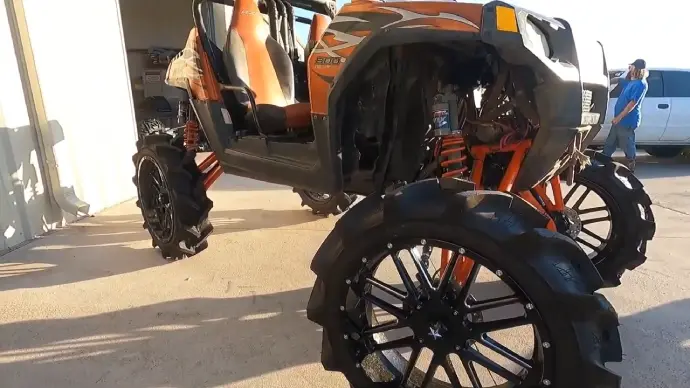Last Updated on May 7, 2023
ATV lift kits offer a variety of benefits, including increased ground clearance and off-road capabilities and more appealing aesthetics. But are they right for all vehicles? Many inquisitive ATV owners have asked this question, wondering if the advantages outweigh any potential drawbacks.
Lift kits can put more stress on the drivetrain, bearings, axles, suspension system and other components while reducing stability and handling.
Before installing an aftermarket lift kit on your ATV, consider factors such as the types of lifts, their compatibility, the condition of the vehicle, its intended use and your budget.
To determine whether or not a lift kit is right for your ATV, we will weigh the pros and cons and consider the long-term effects of such an installation.
Are Lift Kits Bad For Atvs: 4 Factors
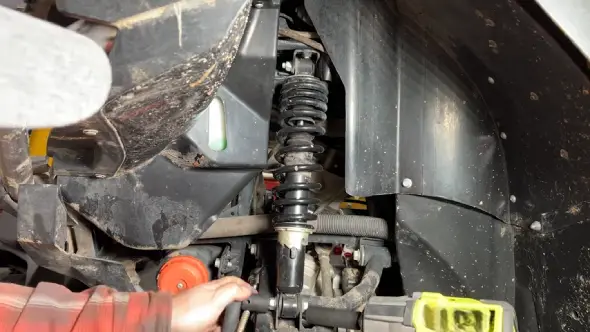
While lift kits can give your vehicle a more aggressive look and greatly improve off-roading capability, there are some drawbacks to consider before leaping. Here are some cons of lift kits you should consider.
1: Increased Stress On The Drivetrain, Bearings, And Axles
The alteration to your suspension can exert extra strain on your drivetrain bearings, axles, and other components. Increased ride height also elevates the center of gravity of your vehicle beyond its original design parameters, which can add additional stress to things like shocks and springs.
To alleviate these issues, try setting the preload for your vehicle’s springs to levels that are appropriate for the new posture of the vehicle. Beware that any change you make will affect the damping coefficients set by the manufacturer, potentially resulting in an unsatisfactory ride quality or, worse, premature failure down the line.
2: Potential For Damage To The Suspension System
When lifting a vehicle’s suspension with a kit, there is potential damage to the suspension system if done incorrectly or with inferior parts. Improperly installed kits may cause damage to shocks and other suspension components.
Raising your vehicle’s center of gravity increases wear and tear on certain components like tires due to increased rolling resistance from having fatter tires while cornering at higher speeds.
Driving your vehicle under tough conditions or when loaded with heavy cargo can cause safety concerns when not outfitted properly. Incorrect alignment and overloading may lead to bottoming-out effects or even part failures that could prove dangerous during regular operation.
3: Reduced Stability And Handling
Raising the center of gravity on a vehicle adversely affects its stability and handling. When making turns at higher speeds, the unbalanced weight distribution between the front and rear ends results in heightened body roll, reducing stability.
When off-roading, decreased traction due to all four wheels no longer being in contact with the ground leads to wheel spin. Extricating without additional accessories such as brackets and shock extensions is difficult.
4: Costly Upgrades
Installing an ATV lift kit usually requires purchasing new tires that are larger than normal ones. It increases tire size which adds cost associated with buying new ones that didn’t come included with the kit itself.
So it should be taken into consideration beforehand along with other associated costs like wheel spacers and wheel alignment services required after installation. It is necessary in order to ensure proper fitment prior to operating the vehicle safely afterward.
The Pros of Lift Kits
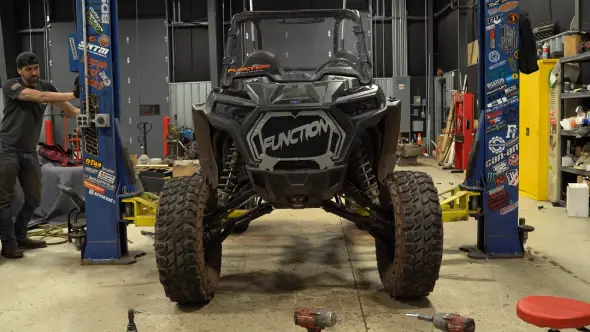
Lift kits are a great way to add more performance to your vehicle. They allow for better ground clearance and off-roading capabilities, improved aesthetic appeal, and larger tire options. Here we will look at the pros of lift kits.
1. Improved Ground Clearance:
When you install an ATV lift kit to your vehicle, you increase the car’s overall ground clearance. This can be beneficial when driving on rough terrain or over obstacles, as it allows the car to pass over them without getting stuck or damaged
It also helps reduce drag from the road during highway driving, increasing fuel efficiency and reducing wear on tires. Additionally, it can give drivers an improved view of their surroundings while they drive since they will be higher off the ground.
2. Better Off-Road Capabilities:
With increased ground clearance, lift kits make off-roading much easier and safer for drivers. Rocks and other obstacles no longer pose a threat since they can easily be passed over without damaging the car’s underbody or suspension components.
The increased height also gives drivers more confidence when tackling steep inclines or declines at slow speeds since there is less chance of bottoming out or scraping against the terrain.
3. Larger Tire Options:
Another benefit of installing a lift kit to a vehicle is allowing drivers to fit larger tires than before the installation was completed. This opens up new possibilities in terms of different tread patterns.
It can be used in difficult driving conditions such as mud, sand, or ice, depending on which tires are chosen for installation purposes afterward by the user itself. It also helps with increasing traction when traversing tough terrain providing another layer of safety for the driver’s peace of mind.
4. Improved Aesthetic Appeal:
As well as improving its performance capabilities, lifting your car with a kit also upgrades its aesthetic appeal in many ways. This makes vehicles look more rugged and aggressive due to its increased size and stance. It can attract attention from onlookers whether it’s parked up or being driven on roads and trails alike.
The extra space between tires also makes them look bigger, making them fill out wheel wells much better than before the kit installation was completed.
Factors to Consider Before Installing a Lift Kit on Your ATV
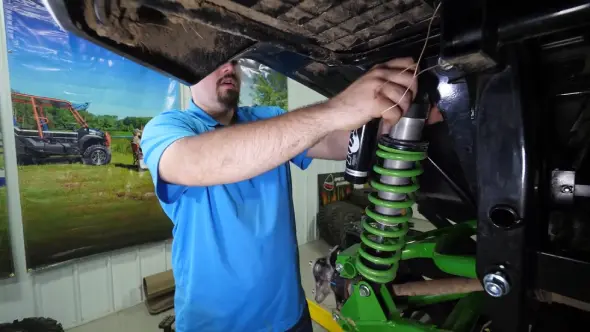
When considering installing a lift kit on your super ATV, there are many factors you should consider. From the type of lift kit and make & model of your ATV to its age and condition, as well as its intended use and budget for the lift kit, you need to look at all these considerations before making a decision.
1 . Types of Lift Kits for ATVs
When it comes to ATV lifts, there are two main types of kits that can be used to raise a vehicle’s height and obtain improved ground clearance: suspension lift kits and body lift kits.
I. Suspension Lift Kits
A suspension lift kit is designed to raise the overall ride height of an ATV by replacing its stock suspension components with aftermarket parts. Typically, these systems include shocks, coil springs, strut spacers, and longer control arms or extended-length axles.
Depending on the vehicle model and brand, some components may be adjustable for added flexibility. As well as providing higher ground clearance for bigger tires and rims, a suspension lift can also improve articulation for off-road performance.
II. Body Lift Kits
A body lift kit adds height to your ATV by raising its body from the chassis without modifying any of its existing suspension parts. This type of kit typically includes replacement body mounts and spacers installed between the frame rails and body panels to increase ride height without compromising safety or performance.
This leveling kit is usually inexpensive to gain extra ground clearance but won’t produce as drastic results as a full-on suspension system.
2. Components Compatibility based on ATV Makes and Models
Before purchasing a lift kit for an ATV, it is important to check if the components are compatible with the make and model of your vehicle. Different brands may have different sizes or shapes unsuitable for one another, so do the research beforehand to ensure that any parts you purchase fit properly.
Certain makes and models may be more suitable for certain types of lifts than others due to their construction or design features, so it is also important to keep this in mind when researching for a lift kit.
A reliable lift kit should provide compatibility with a wide range of makes and models while also allowing for adjustments such as shock mounts, axles, spacers, or brackets specific to each machine.
Some assemblies may need additional parts or modifications instead of stock tires and a stock axle for the lift kit to fit properly. Therefore, ensuring all aspects of the vehicle are considered is essential to finding a compatible lift kit for any ATV.
3. Age and Condition of the ATV
The age and condition of an ATV can impact its ability to handle a lift kit installation effectively. Older model vehicles may lack key components needed for a successful installation or may have worn-down parts. It could prove hazardous with additional weight from the kit components.
Some kits require extensive modifications to be made in order for them to fit correctly onto an older model vehicle. It could result in costly repairs or replacements if done incorrectly. Therefore, it is important to assess both its age and condition prior to installing a lift kit on it.
4. Intended Use of the ATV
The intended use of an ATV should also be taken into consideration before deciding whether or not installing a lift kit is a good idea.
For example, if you plan on using your vehicle off-road then, heavier-duty kits, such as those designed specifically for rock crawling, may be more suitable than lighter kits. They are better suited for recreational riding over flat surfaces only.
Certain types of lifts may offer specific benefits depending on how they will be used, such as increased clearance or improved traction. This should all be taken into account prior to deciding which type is best suited for your needs.
5. Budget for Lift Kit
When shopping around for a particular type of lift kit, it’s important to keep in mind what kind of budget you have set aside for this project. There can be significant differences in price between higher quality kits versus cheaper ones with fewer features included in them.
Consider before investing in any type of aftermarket equipment, including a lift kit as well as any additional components, such as tires or axles, that may need replacing due to size variations.
Specialized kits tend to cost significantly more than universal ones due to their custom design features. So it’s important to weigh all these factors when shopping around and picking one that fits your desired outcome and budget range.
Can You Put a Lift Kit on an ATV?
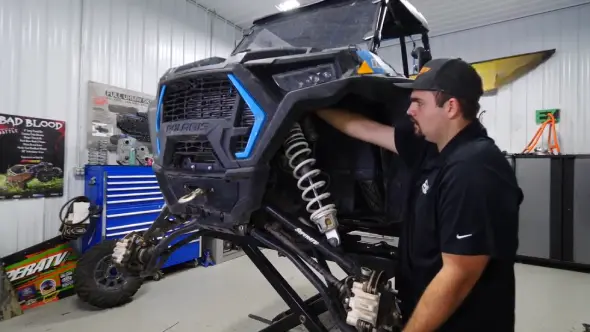
It is possible to install a lift kit on your ATV. The process requires removing the wheels and factory shocks and adding specifically designed components, such as taller springs and suspension arms, to increase the vehicle’s height. After these modifications, you can enjoy improved ground clearance and travel over more land.
Are ATV Lift Kits Worth It?
ATV lift kits can provide numerous benefits that make them worth considering. They offer greater ground clearance which allows you to ride over more difficult terrain with less risk of bottoming out or getting stuck in mud or snow.
Installing a lift kit also usually lets you fit larger tires for improved off-road performance. Your center of gravity will be raised with a higher ride height, resulting in more stability when navigating challenging trails or obstacles.
Consider the Pros and Cons of ATV Lift Kits Before Installing One
While ATV lift kits may give you great satisfaction when you see the results, it’s important to remember that potential risks are involved. Lift kits increase stress on the drivetrain and other components, leading to increased wear and tear and compromised handling and stability.
Consider factors such as types of lifts, compatibility based on ATV model, vehicle age, the intended use of the ATV and budget when deciding if a lift kit is the best choice for you. Weigh all of your options to make sure it’s worth the investment.
